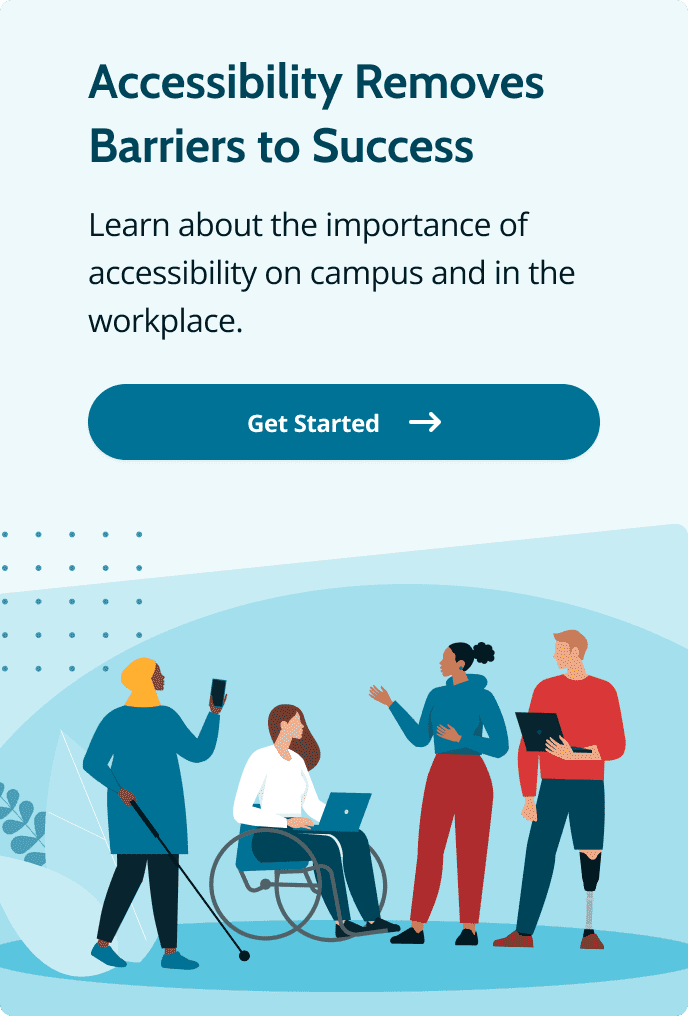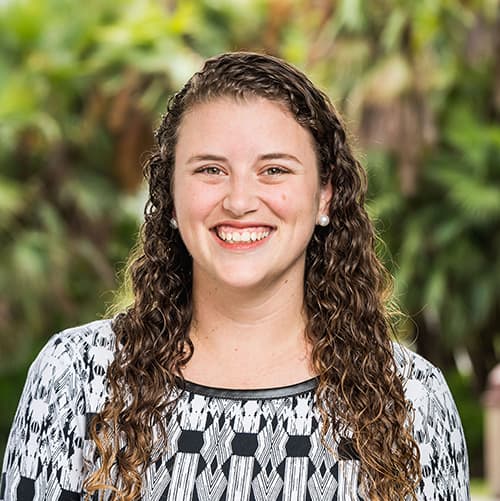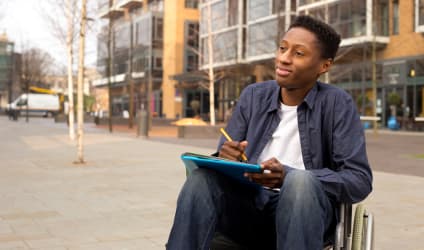College Guide for Students with Disabilities
Writer
Writer
Editor & Writer
Editor & Writer
Reviewer & Writer
Writer
Writer
Editor & Writer
Editor & Writer
Reviewer & Writer
- Disabilities are wide-ranging and come in a variety of forms.
- Per the National Center for Education Statistics, 19% of college undergraduates reported having a disability in 2015-2016.
- People with disabilities can attend college — and thrive.
College is an exciting time of academic exploration and self-discovery. With the right support and accommodations, students with disabilities can excel in the classroom and participate in various extracurricular activities. Unfortunately, college students with disabilities frequently note that accessibility issues, like a lack of working elevators, incorrect use of Braille on signage, and broken wheelchair ramps, impact their ability to consistently attend class and engage with their campus communities.
To be more inclusive of all students, including students with disabilities, universities should adopt the social model of disability. The social model of disability emphasizes universal design, which is the process of creating buildings and infrastructure that are safe and accessible for everyone. It’s also important for students with disabilities to feel empowered to champion their own needs and advocate for support.
All students with disabilities have equal access to higher education, says Oscar Gonzalez, interim accessibility resources senior director at Minnesota State University. He continued, Own your disability, and understand how it shapes your experience. Know that you aren't alone, and be willing to ask for what you need.
Knowing Your Student Rights
Students with disabilities are protected by federal law, enabling them to participate fully in U.S. society. Legislation such as Section 504 of the Rehabilitation Act of 1973 and the Americans With Disabilities Act (ADA) protect students with disabilities against discrimination by creating responsibilities for colleges, universities, and other public organizations.
Americans With Disabilities Act
Created in 1990, the ADA paved the way for a more inclusive society for people with disabilities. The ADA provides a wide range of protections for those with disabilities and created important accessibility standards in employment, public transportation, and telecommunications.
Title II and Title III of the ADA require that both public and private spaces (including college campuses) are accessible to everyone. This means that both private and public universities must make sure that students with disabilities can safely access buildings, equitably participate in the classroom, and reasonably engage in extracurricular activities.
The ADA includes language concerning the various accommodations that should be made available for college students with disabilities, including:
- Communication accommodations for people with hearing, vision, or speech disabilities
- Reasonable accessibility modifications to university policies, practices, and procedures
- Accessibility standards for new and renovated buildings
Section 504
Section 504 of the Rehabilitation Act of 1973 protects college students with disabilities from discrimination. Under this section, any college or university that receives federal funding must provide accommodations so that students with disabilities can participate in the classroom and in educational programs. Some of the accommodations that college students with disabilities may receive include:
- Extended time for test taking
- Recording devices
- Sign language interpreters
Section 504 also applies to K-12 students, but K-12 students receive more hands-on and personalized support. For example, K-12 schools are responsible for finding and identifying students who need accommodations and for providing the necessary support for their academic success.
Colleges and universities, on the other hand, are not required to seek out or identify students who are in need of accommodations. Under Section 504, it is the responsibility of college students to self-disclose and report their accommodation needs. This process often includes submitting official medical documentation to one’s college or university. Students with disabilities who are not seeking accommodations do not need to disclose their disability status to their university.
Most colleges and universities have a designated office and/or website that details the procedures students should follow in order to document their disability with their school. Students are encouraged to begin the accommodations process with their university as early as possible in the school year. This will ensure that your campus has time to set up the appropriate accommodations that will enable you to thrive in the classroom.
Twenty-First Century Communications and Video Accessibility Act
The Twenty-First Century Communications and Video Accessibility Act (CVAA) is a law that Congress passed to update the telecommunications protections for people with disabilities. Previous laws ensured accessibility for telephones and TVs, but couldn't keep up with new technology. The new law includes safeguards for people with disabilities to access the latest technology like broadband, digital, and mobile innovations — the very technologies that the act is named after.
The CVAA has two main sections. Title I requires that broadband products and services (including smartphones) are fully accessible to people with disabilities. Title II makes it easier for people with disabilities to view video programming on TV and the internet. This includes requiring captioning of shows and re-runs on online streaming services.
For college students with disabilities, the act guarantees equal access to information and communication resources, which are vital for academic success. The provisions on internet-based communications technologies require captioning, descriptive audio, and more on public-facing websites and course materials, allowing disabled students, on campus or online, to use technology for their education. This is especially important for certain classroom accommodations and ensures all students have an equal opportunity to learn and participate in campus life.
Assistive Technology Act
The Assistive Technology Act, first approved by Congress in 1988, promotes awareness of and access to assistive services and devices that can help folks in education and work settings, as well as in other activities. Under this law, each state gets grants to help provide services to people with disabilities.
Wheelchair ramps, accessible parking permits, and large-print books are examples of low-tech assistive devices and services. Medium tech can include enlarged computer keyboards and audiobooks.
High-tech devices are those that are computer-based, such as voice recognition software, screen readers, and voice-activated environment controls.
Evaluating Campus Disability Services
Because students with disabilities tend to have specific needs, selecting the appropriate college may present a challenge. Before applying to a school, it's important to learn as much as possible about the school. Explore whether it is inclusive, accessible, and accepting of those with disabilities.
The size of a school's disability services office can provide insight into its ability to accommodate students. The bigger the staff in that office, the more resources and accommodations they're likely to offer.
Visit the school's website and social media accounts. Search for its disability resource center and clubs or networks for students with disabilities and neurodivergent students.
Students who choose to visit campuses in person can make the most out of their time by learning about the school and the disability services office. Also, visit the financial aid office, dining halls, and health services departments. The school may offer virtual tours if an in-person visit isn't possible.
Email or call to schedule an appointment to speak with particular offices and ask them specific questions.
Gonzalez says you should ask the following:
- Can you meet with someone on campus to discuss your accommodations? How will they support you? And what type of resources do they offer?
- Does this college or university have programs to meet your needs? Is there a community for students with disabilities on campus?
- Are there scholarships available for students with disabilities who would like to attend that college or university?
Once you know what accommodations you'll need, Gonzalez says to consider the institution's quality of support services. These include:
- Academic or vocational counseling and planning
- Career training and placement options that align with your interests and skills
- Housing, employment, and financial services
- Social, physical, and mental health and wellness services
When asked how family and friends can support disabled students, Gonzales responded with a few key ways folks can offer support during a student's transition to college. He says it's important to encourage independence and self-advocacy by helping students manage their time and assignments, communicate with professors, and ask for help when needed.
Additionally, it's vital to openly discuss the impact of disabilities on students' lives and what they need to succeed while creating a safe space for others to share their experiences. When accompanying a student to their first appointment with disability services, it's important to prioritize the student's voice and empower them to advocate for themself.
Paying for College
Students with disabilities are eligible for many financial aid and scholarship opportunities.
Federal and state assistance is available. Federal Pell Grants, for instance, do not require repayment. Students with disabilities may also be eligible for government assistance programs such as Social Security Disability Insurance (SSDI) or Supplemental Security Income (SSI).
Nonprofits, schools, and other businesses also offer scholarships. These can supplement students' federal and state financial aid, drastically reducing college expenses.
Students can apply for scholarships specific to their disabilities, as well. The Sertoma Hard of Hearing or Deaf Scholarship and the National Federation of the Blind Scholarship Program are two examples.

Frequently Asked Questions About Students With Disabilities
How do you refer to students with disabilities?
The disability community is split on language. Many people prefer identity-first language: disabled person.
Others prefer person-first language: person with a disability.
The best option is to use the language that an individual prefers. Don't assume all people prefer the same language.
What is a disability resource center?
Colleges and universities typically have disability services offices where students can find help with services and accommodations like assistive technology, note-takers, and extra time on tests.
These centers and offices can coordinate with instructors and other campus departments to provide reduced class loads, priority class registration, and housing and parking accommodations, among many other services.
Some colleges also offer tutors and workshops where students can learn study skills.
Can students with disabilities attend college?
Of course! Disability doesn't mean inability. It just may mean a student has to find unique ways to navigate barriers. People with disabilities commonly attend and successfully complete college. They then enter the workforce.
This is why disability legislation exists. It allows students with disabilities to learn alongside their nondisabled peers. Learn about the various types of support different colleges offer. With the right support, students with disabilities can excel in school.
What challenges do students with disabilities face?
Disabilities are wide-ranging and include learning, physical, and psychological disabilities, health challenges, and vision, hearing, and speech conditions.
Some students with disabilities may face challenges in traditional learning environments due to a variety of factors — sensory sensitivities, mobility challenges, or challenges with subject-specific work.
Students with disabilities may have specific transportation needs and face financial challenges and disability discrimination. It's important to get support from the school's disability offices, campus groups, organizations, and others.
With Advice From:

Oscar Gonzalez
Oscar Gonzalez (M.S.) has served in higher education leadership roles for the past 10 years and is completing an Ed.D. in higher education administration at St. Cloud State University. He currently serves as the interim accessibility resources senior director at Minnesota State University, Mankato, and is part of the President’s Commission of Diversity. In addition, he is the chair of the university's ADA Advisory Committee. Oscar is a member of the Minnesota AHEAD and national AHEAD.








